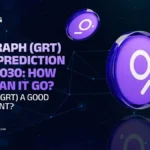The Web3 revolution is reshaping how data is stored, accessed, and monetized. At the center of this change is The Graph (GRT), a blockchain protocol designed to index and query data efficiently. Known as the “Google of Web3,” The Graph enables developers to build decentralized applications (dApps) more effectively.
As investors look ahead, the main question remains: what does the Graph price prediction 2030 suggest for long-term growth? This article explores GRT’s role in Web3, its adoption trends, market challenges, and potential price trajectory by 2030.
Understanding GRT’s Role in Web3
The Graph protocol powers decentralized indexing, allowing developers to query blockchain data in real time using subgraphs rather than centralized APIs. Its infrastructure is essential for:
-
DeFi protocols like Uniswap and Aave
-
NFT marketplaces like OpenSea
-
Decentralized governance platforms
-
Cross-chain interoperability projects
Since Web3 applications rely heavily on data infrastructure, The Graph is positioned as a core enabler. Rising adoption of decentralized services could significantly increase GRT’s relevance by 2030.
Current Market Overview of GRT
As of 2025, GRT is considered a mid-cap cryptocurrency, steadily adopted by developers and integrated across leading Web3 platforms. Its price, however, remains influenced by market cycles and Bitcoin trends.
Key Highlights:
-
Capped Supply: Limits token circulation, creating scarcity.
-
Utility-Focused Token: Rewards indexers, curators, and query processing.
-
Long-Term Incentives: Tokenomics encourage network participation over time.
These fundamentals indicate that GRT has strong utility-driven value—a key factor for the Graph price prediction 2030.
Why GRT Could Become the Next Big Web3 Infrastructure Token
1. Increasing Web3 Data Demand
With more dApps launching on Ethereum, Solana, and Layer-2 networks, fast and reliable blockchain queries will be in high demand. GRT’s functionality as a data access layer positions it as essential infrastructure for the next decade.
2. Developer-Friendly Environment
The Graph’s open-source model fosters innovation. Thousands of active subgraphs show that developers are increasingly dependent on GRT for real-time data, enhancing its long-term utility.
3. Institutional and Enterprise Adoption
Enterprise adoption of blockchain solutions requires dependable infrastructure. By 2030, The Graph could see integration at the enterprise level, boosting real-world GRT usage.
4. Network Effects and First-Mover Advantage
Much like Google became synonymous with search in Web2, The Graph could become Web3’s default search and indexing layer, giving it a significant advantage over emerging competitors.
Challenges Facing GRT
Even with strong fundamentals, GRT faces obstacles:
-
Competition: New indexing protocols may challenge its market share.
-
Scalability: Processing large-scale queries across multiple blockchains requires continuous innovation.
-
Regulatory Risks: Compliance with emerging crypto regulations may slow adoption.
-
Market Volatility: Crypto cycles could impact long-term holders.
Despite these challenges, GRT’s utility-driven adoption differentiates it from purely speculative tokens.
Graph Price Prediction 2030
Forecasting crypto prices involves uncertainty, but analysts consider adoption rates, ecosystem growth, and infrastructure demand for long-term projections:
-
Conservative Scenario: $2–$3 if Web3 adoption grows slowly.
-
Moderate Scenario: $5–$7 with steady dApp and cross-chain expansion.
-
Bullish Scenario: $10+ if The Graph becomes the dominant data layer and gains enterprise adoption.
Expert and Community Sentiment
Developers and investors view GRT as more than a speculative token. Its utility-driven design makes it appealing to long-term holders. Analysts agree that if Web3 scales significantly, GRT will likely be one of the main infrastructure tokens, aligning with positive Graph price prediction 2030 forecasts.
Conclusion
By 2030, GRT could establish itself as a pillar of Web3 infrastructure. With increasing demand for decentralized data, a growing developer ecosystem, and enterprise adoption, The Graph is positioned for long-term success.
While challenges remain, its utility-based model sets it apart from speculative cryptocurrencies. For investors looking to gain exposure to Web3 infrastructure, GRT represents both opportunity and calculated risk. The question may not be “if” but “when” GRT becomes the backbone of decentralized data access making it a key asset in the Web3 era.

